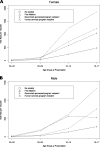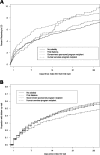Emergency Department Use and Postvisit Care for Anxiety and Stress Disorders Among Children: A Population-Based Cohort Study in Alberta, Canada
- PMID: 26945191
- PMCID: PMC5068196
- DOI: 10.1097/PEC.0000000000000747
Emergency Department Use and Postvisit Care for Anxiety and Stress Disorders Among Children: A Population-Based Cohort Study in Alberta, Canada
Abstract
Objective: We examined sociodemographic trends in emergency department ED visits and postvisit health care for anxiety and stress disorders.
Methods: Emergency department visits (N = 11,289) by children younger than 18 years were extracted from population-based administrative databases from Alberta, Canada (2002-2011). We examined health services use by demographics and socioeconomic proxy (First Nations status, family subsidy type: government, human services program, none). We calculated visit rates and described physician visits after discharge (n = 8075 children). Multivariable survival analyses (with 95% confidence intervals [CIs]) estimate time to first physician visit and ED return.
Results: During 2002-2011, visit rates increased by age, First Nations, and subsidy status. The largest increase was for children (all ages) from families receiving government subsidy (491.43/100,000, P < 0.001). Thirty days after an index visit, most physician follow-up visits were made by children aged 15 to 17 years (61.0%) and from families receiving no subsidy (66.5%). The median time to physician follow-up for First Nations children was 32 days (95% CI, 27-37) compared with 19 days for children from families receiving government subsidy whose median time was shortest (95% CI, 18-23). Children (all ages) in the government and human services program subsidy groups and those who had First Nations status returned earlier to the ED compared with children in the no subsidy group.
Conclusions: Adolescents had high ED use and physician follow-up, whereas First Nations children and those from families receiving subsidy (all ages) had high ED use and low physician follow-up. Efforts to improve disorder identification and treatment among high ED user groups and low physician follow-up user groups are needed.
Conflict of interest statement
The authors declare no conflict of interest.
Figures
References
-
- Keller M, Lavori P, Wunder J, et al. Chronic course of anxiety disorders in children and adolescents. J Am Acad Child Adolesc Psychiatry. 1992;31:595–599. - PubMed
-
- Chavira DA, Stein MB, Bailey K, et al. Child anxiety in primary care: prevalent but untreated. Depress Anxiety. 2004;20:155–164. - PubMed
MeSH terms
LinkOut - more resources
Full Text Sources
Other Literature Sources
Medical



